The post When In Iceland, Go Swimming Inside appeared first on The Expeditioner Travel Site.
]]>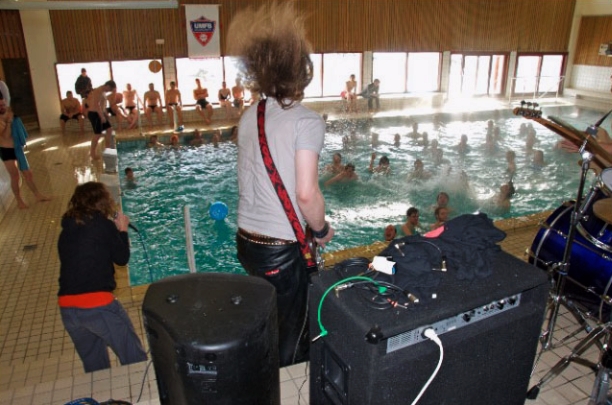
Swimming pool tourism? That’s right. You read it first here.
Iceland is famous for its geothermal activity. Ingenuity has led to utilizing the environmentally sound geothermal energy for 99% of the county’s energy needs. But do you know the unsung hero of all this hot water? It also happens to be the easiest way for foreign visitors to connect with locals in modern Icelandic tradition.
The answer is easy. It’s a trip to your local swimming pool.
What I’m talking about are Iceland’s public swimming pools. There is one in nearly every town around the country, and there are some seriously small towns in Iceland. But no doubt, there will be a swimming pool there. Reykjavik alone has more than eight public pools.
Pools play an important part in modern Icelandic society. Although the country hasn’t won an Olympic medal in this category (handball is their real specialty, by the way), all Icelanders are required to learn how to swim.
Regardless of the fact that I tout swimming pool tourism as an excellent way into Icelandic culture, you will still bump shoulders with some expats and travelers. Pick your pool wisely: some are located in strictly residential areas. Here you are bound to be surrounded by both bearded and bikini-clad Icelanders.
I have to admit, besides the prospects of viewing the northern lights, engaging in swimming pool tourism was my primary reason for my Icelandic stopover. I’m not much of a cold weather guy, and the locals like to really stress how un-cold Iceland is in the winter. “It’s actually colder on average in New York City during winter,” is the anthem I kept hearing over and over. (It’s actually not true, but temperatures are pretty close: here’s the average highs for New York and Reykjavik.)
The temperature was hovering above freezing most of the time while I visited in November, but when the wind whips through, as it often does, it chills you to the bone. Besides the thought of spending the bulk of each day submerged in a 40-degree-Celsius pool was the comforting notion that the hostel would be super-cozy warm (free heating after all) with unlimited hot showers (no need to be concerned with wasting an endless resource).
With these facts in mind I booked my return one-way ticket from Europe to the U.S. using Iceland Air, which also happened to be the cheapest way home. Iceland Air offers a free stopover for up to seven days. Good for us — even better for them (the airline owns a series of hotels and tour services around the country).
My fascination with this seemingly ordinary activity began three months prior when visiting Iceland in the summer (when I also booked a stopover). In the small town of Hveragerdi, less than an hour outside of Reykjavik, I had set off on a fool’s errand to find a series of natural hot springs located a few miles up a mountainside.
Even though it was summer, the weather was cool, rainy and windy, the combination being too much for my wool socks, long underwear and waterproof jacket. We never made it to the springs. In between us and our natural hot spring destination was an impassable gushing stream, spilling over its banks by all the recent rain. This forced us to turn around and return to the car.
Sitting in a rental car soaked to the bone is not a preferable way to spend a holiday, so we immediately drove to the Hveragerdi swimming pool, where we soaked for a couple hours in the hot pools and shocked our bodies in the natural steam bath.
Back in Reykjavik, months later, I was on a mission: Go to the swimming pool every day for as long as possible. I pulled out my map of Reykjavik and studied it at the front desk of my hostel. With the help of the staff, I strategically planned out my week of pool hopping.
Each pool here has a particular character, with its own special features. Downtown-located Sundholin Pool is the oldest, but recently refurbished, and it features an Art Deco swim hall from 1940. Laugardalslaug is the largest complex and features a 50-meter pool and a series of 5 hot pools ranging from 38 to 44 degrees. Vestubaejarrlaug Pool is located in a quiet neighborhood, offering a more local experience. Grafarvogslaug, in the city’s northwest, features a state-of-the-art sports complex in addition to its three hot pools and hydro-massage. Most facilities have children’s pools and waterslides (for kids and adults).
The water in the pools, I should note, is actually pumped up from under the earth — it’s not circulated below the ground or heated with electricity. It’s the same hot water that is pumped to every household in the country, and it has a slight odor of sulfur to it.
The one thing that every travel writer loves to point out about public swimming pool protocol here is the graphic images in the locker room showing bathers exactly where he or she should wash. There are no chemicals in the water, so it’s important that everyone is clean before entering. The areas are highlighted on the cartoon diagram of a human figure. I followed suit each time and washed my hair and face, under my armpits, my groin, and my feet with the provided soap.
The night I was leaving after a swim at Sundholin, I asked two Reykjavik girls about the other pools in town and which they recommended. “They’re each a bit different. But we like Vestubaejarrlaug, and Bjork goes to this one.” They pointed on my map. I smiled and drew a little asterisk next to that one. I was truly falling in love with Iceland.
More Info
Each pool charges an entrance fee of about 450-500 kroner, which is less than USD$4.00.
Expeditioner Tip
If you really want to get your Icelander on, get a hot dog and Coke at the snack stand outside the pool in true Icelandic fashion.
[Doom in the pool in Bolungarvik, Iceland by Greg Neate/Flickr]

About the Author
 Stephen Bugno has been traveling the world and writing about it for the past decade. He prefers slow and low to the ground travel and will make a temporary office wherever the weather is warm and the interneting good. He blogs at Bohemian Traveler and GoMadNomad, and you can follow on Twitter: @bohemiantrav.
Stephen Bugno has been traveling the world and writing about it for the past decade. He prefers slow and low to the ground travel and will make a temporary office wherever the weather is warm and the interneting good. He blogs at Bohemian Traveler and GoMadNomad, and you can follow on Twitter: @bohemiantrav.
The post When In Iceland, Go Swimming Inside appeared first on The Expeditioner Travel Site.
]]>The post 7 Tips For Travel In Southeast Asia appeared first on The Expeditioner Travel Site.
]]>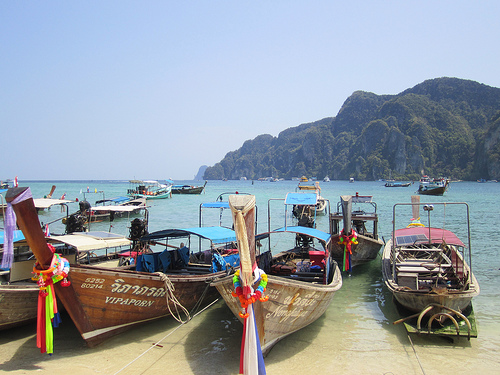
Southeast Asia is probably the best place in the world for your first extended backpacking trip. The food is delicious, the locals friendly, the beaches extraordinary, the accommodations well-established and the sites varied and unforgettable. You’re likely to return home with plenty of fond memories and incredible photos of Southeast Asia. If you’re considering setting off for Thailand, Malaysia, Laos, Cambodia, Vietnam, or any other country in the region, keep these tips in mind.
1) Stay Longer in Fewer Places
One of the biggest mistakes I saw was travelers rushing through an itinerary with too many places in too little time. No matter how long your trip is, it’s advantageous to go fewer places, while spending more time in each place. I would also encourage you to take more time than you think you need or want. Chances are you’ll wish you had more time.
On my recent trip to Southeast Asia, I saw one young backpacker who had begun to resent the region. He had been pushing too quickly to “see” whatever it was that he thought he had to see, ran into some unexpected difficulties and got extremely frustrated. Take it more slowly and you’ll have a better trip.
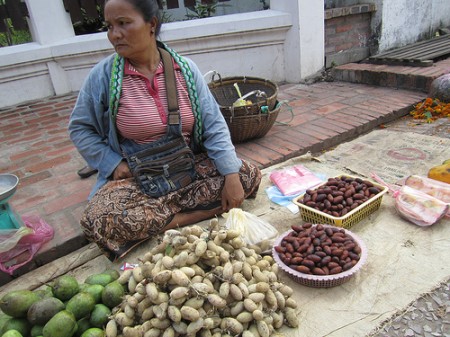 2) Don’t Plan Too Much
2) Don’t Plan Too Much
Leave room for spontaneity. That’s part of what makes traveling fun. You might want to plan a basic outline of the major places you want to visit. But give yourself plenty of time to absorb the atmosphere of the cities and villages and leave time in case you meet people and decide to do an impulsive side trip.
There’s no need to make reservations anywhere in Southeast Asia. You can just show up and shop around for your accommodation. I traveled for three months and never made one. I had a roof (and an inexpensive one I’ll add) over my head each night.
3) Travel With a Different Guidebook
Everybody has a Lonely Planet guidebook. Don’t buy one. Get a Rough Guide, Moon or Footprint. Lonely Planet channels everyone into the same guesthouses and hostels and that drives prices up. Plus, these guesthouses fill up more quickly. A good tactic is to check out a few guesthouses located around the ones listed in your guidebook. They are usually of the same standard and sometimes cheaper. I also always look at more than one place . Bargain friendly, and take the one that suits you best.
I generally choose my guidebook by the one that has been updated most recently. And remember, if at times of weakness, you are missing your LP, chances are the backpacker on the bus in the seat next to you has one.
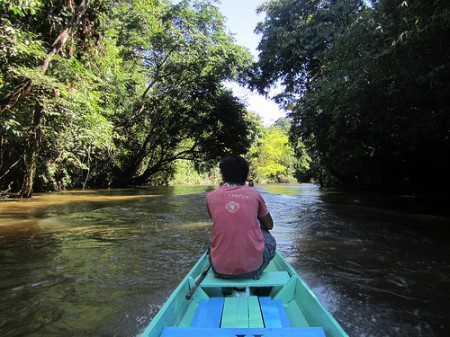 4) Avoid Multi-Day Packages and Backpacker-Only Buses
4) Avoid Multi-Day Packages and Backpacker-Only Buses
These are designed to make traveling easier. Organizers facilitate border crossings, transportation connections, accommodation and sometimes visas. In my opinion, this takes the fun and challenge out of independent travel. Figuring out transportation logistics is half the battle of traveling. Our detailed guidebooks make it easy enough, anyway. The multi-day packages also keep backpackers together and discourage interaction locals.
Another reason to avoid these packages, as well as international buses and VIP buses, is that you become an easier target for scams. In general Thais are pretty honest people, except when it comes to the individuals running the foreigner-only long distance buses from Khaosan Road to the rest of Thailand. I’ve heard some nasty stories of long delays, stranded travelers and multiple accounts of theft. Best to keep to the normal buses that leave from the bus stations.
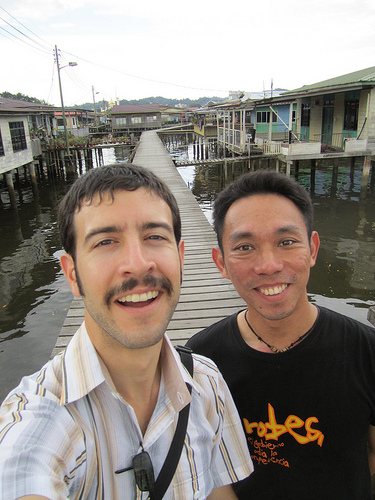 5) Travel With a friend; Travel Alone
5) Travel With a friend; Travel Alone
If you are traveling alone, great, you will meet plenty of people, both local and fellow travelers. If you are traveling with a friend, you will get lots of quality time with that person. Try to structure time away from your travel companion for a couple of reasons.
First, it will give you the independence to experience traveling on your own: meeting new people, making your own mistakes and choosing your own adventures. Secondly, it will improve and strengthen your relationship with your friend/partner when you return to each other. I used this scenario during two different trips with a good friend and it worked well. I also noticed that I have different and richer travel experiences when I’m alone.
6) Pack Light
This is one of my universal travel truth tips. It is always a good idea to pack as light as possible. Remember, you’re carrying everything on your back. Carrying less will obviously be lighter and increase your mobility, but it will also make getting in and out of transport, and to and from your accommodation easier. There’s really no need to take more than three or four changes of clothes.
If you’ll be working from the road or are a serious photographer, you might have a decent amount of equipment (extra lenses, external storage devices and laptops). But, most of us can just hit the road with a medium-sized backpack and small personal bag for valuables. I generally put nothing of value in my backpack. Although crime and theft in Southeast Asia is very unusual, I still want peace of mind when I throw my bag under or on top of the bus. And if your backpack is small enough, you may be able to carry it on with you, including during your flight, which could also save you money.
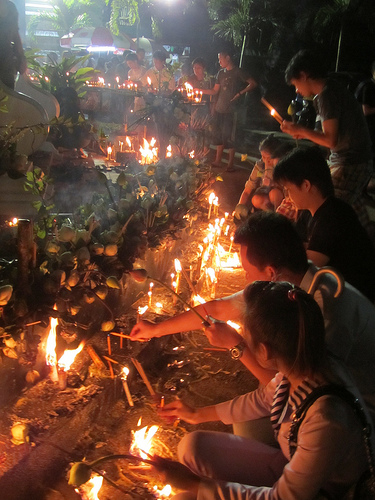 7) Avoid Burnout
7) Avoid Burnout
If you’re going to be traveling for more than two months, you’re going to need to recharge your batteries. Everybody does this in his or her own way. It could be alone with a book, a film, spending a day inside a nicer hotel room, eating comfort food, playing football — whatever.
Know yourself and know what you need to get a fresh perspective of where you are and what you’re doing. I’ve seen travelers get really frustrated and begin to develop animosity towards the country that they’re in at the time.
Author Paul Theroux, in his latest book, suggests bringing reading material unrelated to the country in which you’re traveling. At the end of a culturally intense day in Cambodia, you probably don’t want to wind down by reading a book that takes place in Southeast Asia. Rather, take one that will provide some relief through means of escape.
[All images via the author]

About the Author
 Stephen Bugno has been traveling the world for more than a decade as both a volunteer and a wanderer, and is the editor and publisher of the online travel magazine GoMadNomad.com and his personal site BohemainTraveler.com. You can follow Stephen via twitter at @bohemiantrav or on Facebook.
Stephen Bugno has been traveling the world for more than a decade as both a volunteer and a wanderer, and is the editor and publisher of the online travel magazine GoMadNomad.com and his personal site BohemainTraveler.com. You can follow Stephen via twitter at @bohemiantrav or on Facebook.
The post 7 Tips For Travel In Southeast Asia appeared first on The Expeditioner Travel Site.
]]>The post An Unforgettable Tour Through Southeast Asia [Photo Essay] appeared first on The Expeditioner Travel Site.
]]>From the 1000-year-old temples, to the food, to the other backpackers one encounters on such a trek, what follows, I hope, is a gentle kick-in-the-behind motivation for those thinking of traveling there.
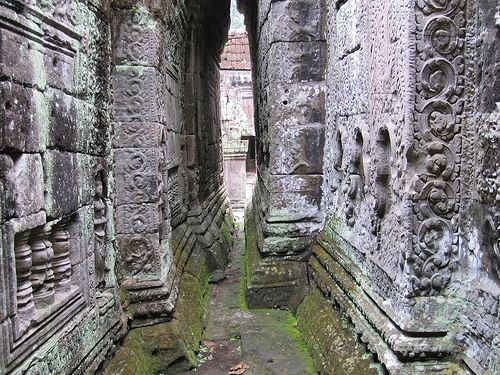
The walls at Preah Khan, probably the most famous temple in Angkor, Cambodia.
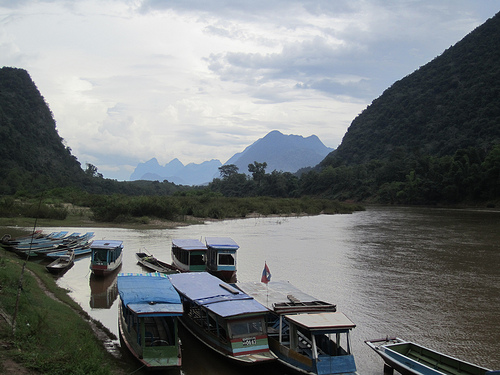
Looking downstream in Muang Ngoi, a Lao town along the Nam Ou River.
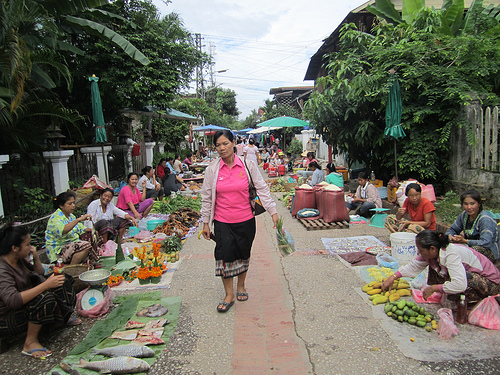
An early-morning stroll in Luang Prabang’s morning market, north central Laos.

Dinner during a two-day trek to an Akha hill tribes village near Phongsali, the northernmost province in Laos.
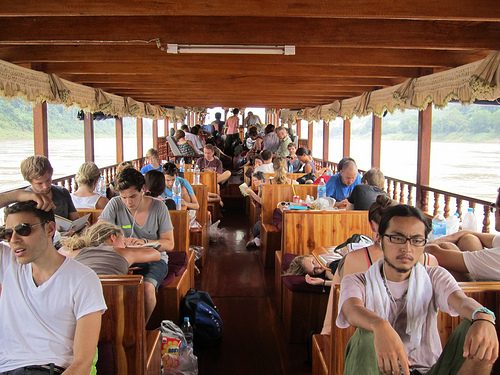
Taking the slow boat ride down the Mekong River in Laos from Houayxai to Pakbeng.
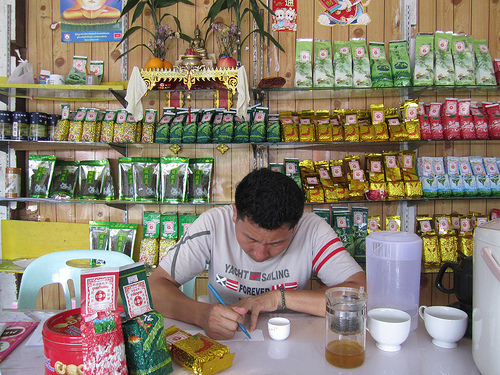
This tea salesman, in the Chinese village in northern Thailand called Mae Salong. is writing out the brewing instructions I asked for.
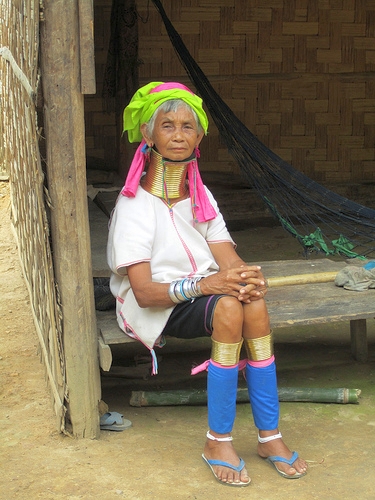
An older woman from Mae Hong Son, in northern Thailand near the border of Burma.
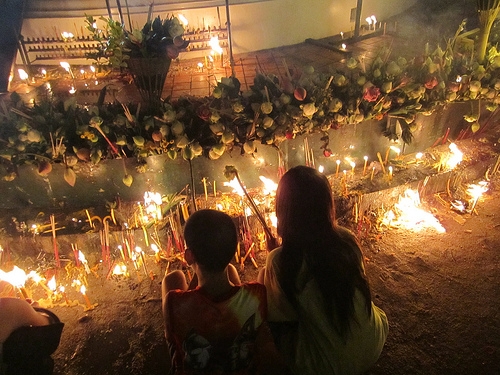
Visakha Bucha Day in Chiang Mai. The holiday celebrates the birth, enlightenment and entry into nirvana of the Buddha.
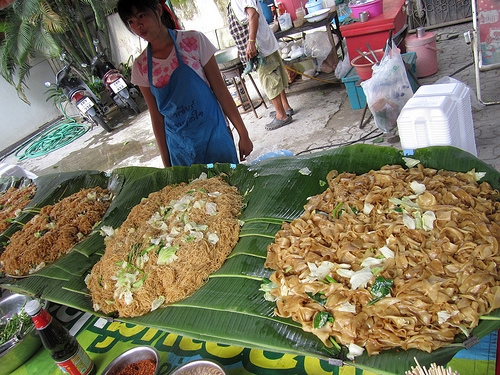
A vendor prepares for the crowds at the night market in Chiang Mai.
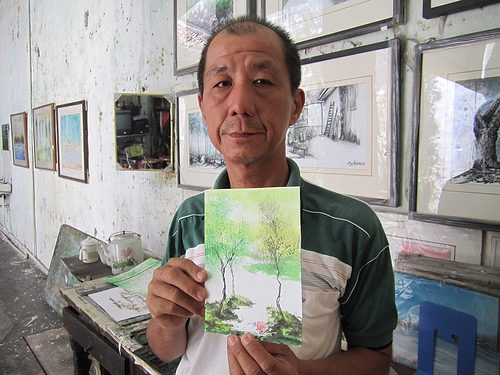
Stanley Ho, my favorite artist in Melaka. He’s holding the painting I bought from him. Visit Stanley at 46 Jalan Tun Tan Cheng Lock in the old part of town. He loves to chat.
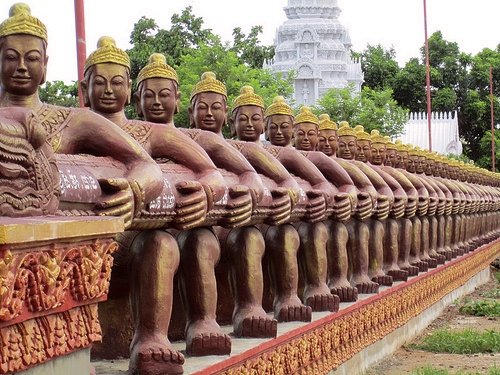
Near Kampong Cham in central Cambodia is the 11th-century religious compound, Wat Nokor.

Sunset in Kota Kinabalu, Sabah, Malaysia.

About the Author
 Stephen Bugno has been traveling the world for more than a decade as both a volunteer and a wanderer, and is the editor and publisher of the online travel magazine GoMadNomad.com and his personal site BohemainTraveler.com. You can follow Stephen via twitter at @bohemiantrav or on Facebook.
Stephen Bugno has been traveling the world for more than a decade as both a volunteer and a wanderer, and is the editor and publisher of the online travel magazine GoMadNomad.com and his personal site BohemainTraveler.com. You can follow Stephen via twitter at @bohemiantrav or on Facebook.
The post An Unforgettable Tour Through Southeast Asia [Photo Essay] appeared first on The Expeditioner Travel Site.
]]>The post Ask An Expert: How To Travel Cheap appeared first on The Expeditioner Travel Site.
]]>
GoMad Nomad recently introduced a new “Ask GoMad Nomad” feature on their site (à la the seemingly defunct “Ask Rolf” series on World Hum). In its inaugural post, GoMad tackles a very familiar question that pretty much all travelers face at one time or another: How to travel without going broke?
GoMad recommends exploring the idea of ditching the whole “travel” thing and, instead, relocating to your destination for a while, an option that allows you to not only spend an extended period of time there, but often gives you the opportunity to give a little something back as well. Try volunteering, or even a help exchange, where your work can be rewarded with some room and board. GoMad also lists a few house sitting sites, including Mind My House, House Careers, and House Sit World, where you can save those precious travel pennies in exchange for living in and taking care of a furnished house.
My two cents? (It is my post, I can butt in when I want.) I’ve always found that the best way to extend your cash is to simply watch what you eat and drink. Nothing adds up more than eating out three times a day and loading up on mid-day beers and drinks. Of course you want to explore the local cuisine, that’s part of travel, but that doesn’t mean every meal, and it doesn’t mean you have to spend a lot to do it. Eat cheap for breakfast and lunch (buy a box of cereal, buy some bread at a bakery, load up on breakfast bars), then splurge for dinner at the more pricier options, or just stick to the cheaper street food (which, as is often the case, is some of the best, traditional food you’re going to find anyway). And maybe you come back a few pounds lighter from your trip — a win-win situation.
The post Ask An Expert: How To Travel Cheap appeared first on The Expeditioner Travel Site.
]]>The post What You Need To Know About CouchSurfing appeared first on The Expeditioner Travel Site.
]]>
There were a number of confused reactions this weekend at the NYT Travel Show by the more senior members of the audience when the speakers would get into such things as Facebook, Twitter, and Foursquare. But there was perhaps no greater confusion (and sometimes indignation) than when the topic turned to CouchSurfing.com.
Of course, for most travelers, CouchSurfing is just one of the many tools in their arsenal for budget and immersive travel. The opportunity to lodge free and, more importantly, to make new friends and live like a local is a no-brainer. However, the idea of shacking up in some stranger’s house still causes many to shy away from the world’s largest travel social networking tool.
But, like British humor and soy milk, the preconceptions are quickly dispelled with just a little explanation. Stephen, over at GoMad Nomad, recently tackled this very subject.
Too Old?
Steve (I can call him this, I bought him a happy-hour priced beer) points out that though a great majority of surfers are in the sub-30 range, there are almost 50,000 over-50 participants (and many more in between).
Hate Couches?
Steve explains (as many of us have experienced), that couches are often the exception not the norm. Most people are offered up beds in spare rooms, futons, and an some occasions, their own guest house.
What Do You Owe?
Well, it depends. “You aren’t required to give your host anything . . . You may want to show up with a bottle of wine, treat them to dinner or a drink, or cook for them. There have been certain times traveling when I was financially inadequate and could only offer my in-kind contribution of making their house/apartment cleaner than I found it.”
* * *
My own experiences with the site have been incredible. I’ve used the site to meet new friends everywhere from Bogota, Dublin and Stockholm. I stayed gratis in Cork and Montreal (see the above couch), and I’ve hosted and became great friends with surfers from Canada, Ukraine, and Australia. In fact, almost every traveler I’ve met has had a positive story to tell about the site. Feel free to share your own experience below.
For Stephen’s full article click here.
The post What You Need To Know About CouchSurfing appeared first on The Expeditioner Travel Site.
]]>The post Majestic Mountains, Beguiling Towers, And Lawless Bandits, Oh My appeared first on The Expeditioner Travel Site.
]]>With the disappearance of the lawless bandits and random kidnappings, what’s the most likely reason for not returning home? Try not wanting to leave.
Our friend back at the embassy in Tbilisi dutifully passed on warnings from higher-ups advising us not to go or, if we were so intrepid, to at least hire a guide. They warned us about the bandits and we listened to stories of foreigner kidnappings that went in one ear and out the other. We had done our research and decided the quest was worth the minimal risk we thought it posed to our safety.
The place in question was Svaneti, a sparsely-populated, high-altitude region of the Republic of Georgia, sandwiched between the infamous conflict areas of South Ossetia and Abkhazia. We read that the situation had grown so bad that back in 2003, after a wave of increased murders and robberies of foreign tourists, the Georgian Interior Ministry deployed a special-purpose unit to restore order in the Mestia District.
At dusk we boarded the overnight train at the Tbilisi station and shortly after dawn we rolled into the drowsy town of Zugdidi. We made our way to the makeshift bus station. Here we hesitantly handed over our passports to buy the tickets for the next part of the journey.
The woman behind the kiosk registered us as foreigners entering Svaneti and assured us there hadn’t been any kidnappings in over four years. After waiting an hour we lashed our backpacks to the rack on the dented roof and boarded the rusting van, squeezing ourselves onto one of the ripped-upholstery benches. Most of the next four-and-a-half-hour haul would wind us through a river gorge ascending past several shades of greenery.
Despite the early hour, my inquisitive and uninhibited travel partner struck up a conversation with the mixed-age crowd crammed inside the van. As the roads deteriorated, those on board became friendlier. They were teaching us some basic words in Svan, a South Caucasian language spoken only by some 30,000 inhabitants of the region. Having no written language, most Svans know Georgian and a smattering of Russian, which became our common tongue.
The unforgiving jolts and jerks of the partially paved road abruptly came to a halt. The van stopped. Everyone fiddled through his or her bag for an empty plastic bottle. Stepping out into the sunshine we stood confused, watching our new friends make their way down to a small stream.
One by one they bent down and filled their bottles from what looked to be the source of a stream. It was a spring bubbling out of the ground. “Good water?” I asked a man in my newly acquired Svan. He smiled, assuring me it was safe to drink. We couldn’t believe the water came out of the ground already carbonated. And like it or not, the mineral water in these parts has a salty, sulfur flavor that is certainly an acquired taste.
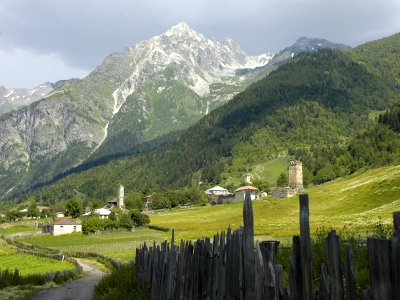 After driving another 30 minutes slowly up the gentle grade, we entered Upper Svaneti. Here huge stone watchtowers appeared, rising out of the landscape. It seemed like most houses in the villages that speckle this long, scenic valley had one. They were mostly built in the 9th to 12th centuries to store grain and provide safety for the families from attackers. Behind the villages, in the near distance, a series of 15,000-foot mountain peaks loomed over us.
After driving another 30 minutes slowly up the gentle grade, we entered Upper Svaneti. Here huge stone watchtowers appeared, rising out of the landscape. It seemed like most houses in the villages that speckle this long, scenic valley had one. They were mostly built in the 9th to 12th centuries to store grain and provide safety for the families from attackers. Behind the villages, in the near distance, a series of 15,000-foot mountain peaks loomed over us.
Upon arrival in Mestia, the regional capital, we navigated through the town’s few streets with the help of some residents and found the family with whom we would be staying. They were pleasant, and after a cup of tea and brief chat to get acquainted, we strolled through the wide, Soviet-era streets, past the empty main square and made our way to the regional museum.
The next morning our host packed us a generous lunch and we set off for an ambitious walk. We hoped to make it to Ushguli, the highest continually inhabited village in Europe. To manage the some 40 kilometers, we would need the help of a passing vehicle for a lift.
We kept our expectations to a minimum, and with that mindset we weren’t disappointed — no cars ever passed us, on this, the only through road in Upper Svaneti. But it was all for the better. At our pace we slowly absorbed the alpine scenery: wildflower-drenched fields, a quick-flowing river, sounds of cow-bells, and sights of inviting villages along the way, all with the uneasy thought of bandits still in the back of our minds.
Soon we started climbing up the switchbacks, still with no sign of any passing cars. Almost to the pass, we came upon the calmest of ponds in a picture-perfect setting. We unpacked our lunches and ate while sitting beneath the stunning mountain backdrop.
After lunch we finished the climb to the pass and looked out into the next valley. We stood in silence. The huge expanse in front of us stifled any words that might have come out. With Ushguli only a spec on the horizon, we realized it was too far and turned around with regret.
Coming down from the pass, we saw the village of Saldashi, with its old-fashioned homesteads surrounded by large plots of land and rickety picket fences, just a few hundred meters to the north. We wandered up the dirt road and saw an elderly couple outside of their house. We looked at them. They looked at us. Out of curiosity, they called us over.
“You boys must be hungry,” the man said in Russian, prompted by his wife who must have noticed that we looked like we’d been walking for hours.
With that we were quickly introduced to the Zredeyani couple, Kolya and Julieta. With a nice plot of land big enough to raise a couple cows, some pigs, and a sufficient vegetable garden, they sustained themselves through the harsh winters.
We sat down at the table and Julieta placed a bowl of soured milk in front of us. Without a doubt it came from their cow outside. We sponged it up with homemade bread. Kolya chatted with us as Julieta sat watching the inconsistent signal on their black and white TV.
“Is it safe around here?” we inquired.
“It’s not dangerous,” he replied. “Even all throughout the night.” Of course we were talking about the bandits. Not realizing it, he answered us regarding the general safety of the area.
We drifted outside and the light of day revealed the wrinkles of Kolya’s face that had endured these cyclical patterns for decades. Pointing to the the wall, he showed us how far the snow piles up in the winter (about 3 1/2 feet). Although only early July, they were already preparing for the six-month season.
Together we looked out from the front yard as Kolya pointed out Mount Shkhara and the names of the surrounding mountain peaks and villages. But we were heading in the opposite direction, towards the valley to Mestia. We thanked Kolya and Julieta profusely and headed back down the dirt road.
We walked quickly, knowing a solid three-hour march was ahead of us. After about an hour, two guys in an old beat-up van pulled over next to us. They waved us inside, cleared off the back seat, and we hopped in. Russian once again became the lingua franca and we managed to converse despite the clamoring suspension and clouds of dust.
“So we hear Svaneti’s a dangerous place?” we shouted over the roar of the engine.
“Aww, you can’t believe everything you hear,” they shot back. “It was a bit dangerous back during the civil war, but no more.”
He followed that by listing the name of every bandit’s name he could remember.
The conversation unexpectedly halted when we pulled over without warning. We looked at each other with furrowed brows, wondering what the problem was. When we saw them reach for their empty bottles we knew exactly why. We leapt out and sauntered down to the spring. We drank our fill of the water. It tasted different this time.
“Each one has just a little bit different flavor to it,” they informed us, referring to the unique mineral content of individual springs.
45 more minutes of shakes, bumps and intermittent conversation, we were back in Mestia.
During dinner, our home-stay host — who happened to be a local government official — talked to us about our safety and security reservations after we brought up the topic for the last time.
In fact, he explained, “Svaneti was a dangerous place some five years back. Former soldiers used to hide out and watch villagers go up to Mestia to sell their vegetables. Then they would rob the villagers full of their earnings, when they returned.” He continued. “And a van load of German tourists were fired on back in 2000.”
Shock showed on our faces.
“No one was killed,” he stressed, “but it’s been quiet since 2004 . . . After that point, the region ceased being a safe-haven for criminals. Security has tightened and since then it’s been safe for both locals and foreigners.”
Our time in Svaneti had come to a close and early the next morning we wound our way back down through the steep, tree-covered river gorge with an overwhelming impression of the sheer beauty of the landscape and the warmth and hospitality of this isolated, ancient culture.
Back in Tbilisi, we reported our return to our skeptical and curious friends at the embassy. We had survived our trip to Svaneti.

The post Majestic Mountains, Beguiling Towers, And Lawless Bandits, Oh My appeared first on The Expeditioner Travel Site.
]]>